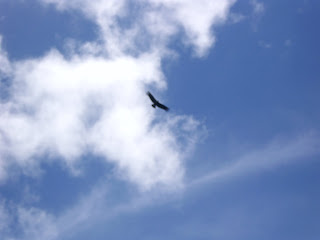
The Condor. It is, essentially, a big vulture. It is, therefore, an ugly bird. Its head is bald, and its beak hooked, so it can rummage through the carcasses of fallen animals without blood congealing on its feathers. However, when I use the word big, read, absolutely bloody huge. Yes, it is the size of the bird that makes it magnificent, and beautiful.
The first Condor we saw was with Rufo, when we were doing the Che Guevara tour (blog on that coming soon!) In the distance we saw a bird, gliding on unseen thermals. To my untrained eye it seemed like any other bird of prey. Elegant and menacing on the wind. But Rufo knew it was a Condor. We had been driving down a perilous, cliff hugging stretch of road, with Rufo cautiously guiding the 4x4. As soon as he saw the bird though, he threw caution off the cliff, and accelerated to a speed that nearly changed the colour of my pants. The condor was descending, and Rufo wanted to race it to get a good view. I would like to see a condor, I thought, as we sped around a tight hairpin bend, but I would also like to survive. When I tried to voice my thoughts, however, they came out in nothing but a whimper. When we got to the point where the bird should have been, we saw the last of it's tail feathers float behind a wall of rock.
Three days later, we were off with Rufo again, this time with the sole purpose of seeing condors. It was our third tour with the great "gordito (chubby)" guide, and this time we had an Australian couple, a Mexican, an American and a highly irritating German girl in tow.
It was a 4 hour trek across a ridge, up steep hills that Rufo, in the traditional Bolivian manner, assured us were "slight inclines." (It is a strange quirk with Bolivians, that distances and measurements seem to mean nothing to them. They are not trying to annoy or fool you when they say the shop is 5 minutes away, and 2 hours later you're gasping for water in the peaks of the Andes. They just measure things in their own, speecial way. Similarly, if you ask a Bolivian for directions, they will give you them, whether they know where your intended dedstination is or not. So, you have to ask half a dozen people the same question, and cross reference the answers!)
The walk, however, was beautiful. Every dozen metres you climbed, the landscape seemed to change, becoming less green, more harsh. Eventually, we got to our vantage point. On a narrow ledge, we looked down to a small rock escarpment, a hundred metres below. A waterfall plunged over the edge, and huddled around the rocks were the birds.
The place Rufo led us to was like an airport for Andean Condors. At any one time there were seven or eight birds by the waterfall, playing with eachother, drinking and pruning themselves. All the time there were new arrivals, or departures. Condors would swoop down the valley, circle once or twice, and come in to land. They were enormous. We were close enough to appreciate their size as they flew overhead. The wingspan can reach three metres. You can see the shadow of a condor on the valley floor as it glides imperiously hundreds of metres above. And they are masters of the air...some would take off in twos, and fly around the valley in tandem, in a formation sychronised to a perfection that would impress the Red Arrows. Rarely flapping their wings, they can glide for hundreds of kilometres without stopping. Some of the condors we were watching may have flown to that point, in landlocked Bolivia, from the Pacific ocean. As they glide, you can appreciate their size and formidable weight, as they are not buffeted by the wind, as the other smaller birds we saw (vultures and hawks) were. They have an elegance and a grace incongruous with their ugly features. In flight they are stunning, but on the ground they are horrendous.
Apparently, the place we were that day, deserted and isolated, is the best place to see Condors in the world. I wasn't sure, until rufo said, "Vamos" (Let's go!) As if on cue the condors begin their grand finale. Four or five would take to the sky at once. Above and below, and on every side there were condors. I was trying to count them, but in the end we could only estimate. We saw between 40 and 50 of the birds that day. We had to walk for seven hours, and the 3 hour descent was through a rainstorm that turned the pathway to a river, but I was grinning like a maniac all the way down. Drenched but happy. Becuase, like seeing the ferns in Amboro, seeing condors brought me close to nature, and close to a presious animal that we almost wiped out. to see so many, flying with a liberty we can only dream of, was an amazing experience. They are sky-kings, giants of the air, the mightiest birds of all. Condors.
No comments:
Post a Comment